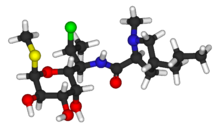Klindamicin je organsko jedinjenje, koje sadrži 18 atoma ugljenika i ima molekulsku masu od 424,983 Da.[6][7][8][9][10][11]
Klindamicin

|

|
|
|
| Klinički podaci
|
| Robne marke
|
Chlolincocin, Cleocin, Cleocin Hcl, Cleocin Pediatric
|
| AHFS/Drugs.com
|
Monografija
|
| Identifikatori
|
| CAS broj
|
18323-44-9
|
| ATC kod
|
D10AF01 , J01FF01
|
| PubChem[1][2]
|
29029
|
| DrugBank
|
DB01190
|
| ChemSpider[3]
|
27005
|
| KEGG[4]
|
C06914  Y Y
|
| ChEBI
|
CHEBI:3745  Y Y
|
| ChEMBL[5]
|
CHEMBL187  Y Y
|
| Hemijski podaci
|
| Formula
|
C18H33ClN2O5S
|
| Mol. masa
|
424,983
|
| SMILES
|
eMolekuli & PubHem
|
| InChI |
|---|
InChI=1S/C18H33ClN2O5S/c1-5-6-10-7-11(21(3)8-10)17(25)20-12(9(2)19)16-14(23)13(22)15(24)18(26-16)27-4/h9-16,18,22-24H,5-8H2,1-4H3,(H,20,25)/t9?,10-,11+,12?,13+,14-,15-,16-,18-/m1/s1
Key: KDLRVYVGXIQJDK-NOWPCOIGSA-N  Y Y |
|
| Fizički podaci
|
| Tačka topljenja
|
142 °C (288 °F)
|
| Farmakokinetički podaci
|
| Poluvreme eliminacije
|
2,4 h
|
| Izlučivanje
|
Urinom
|
| Farmakoinformacioni podaci
|
| Trudnoća
|
?
|
| Pravni status
|
|
| Način primene
|
Oralno, Intravaginalnono, topikalno, intramaskularno, intravenozno
|
- ↑ Li Q, Cheng T, Wang Y, Bryant SH (2010). „PubChem as a public resource for drug discovery.”. Drug Discov Today 15 (23-24): 1052-7. DOI:10.1016/j.drudis.2010.10.003. PMID 20970519. edit
- ↑ Evan E. Bolton, Yanli Wang, Paul A. Thiessen, Stephen H. Bryant (2008). „Chapter 12 PubChem: Integrated Platform of Small Molecules and Biological Activities”. Annual Reports in Computational Chemistry 4: 217-241. DOI:10.1016/S1574-1400(08)00012-1.
- ↑ Hettne KM, Williams AJ, van Mulligen EM, Kleinjans J, Tkachenko V, Kors JA. (2010). „Automatic vs. manual curation of a multi-source chemical dictionary: the impact on text mining”. J Cheminform 2 (1): 3. DOI:10.1186/1758-2946-2-3. PMID 20331846. edit
- ↑ Joanne Wixon, Douglas Kell (2000). „Website Review: The Kyoto Encyclopedia of Genes and Genomes — KEGG”. Yeast 17 (1): 48–55. DOI:10.1002/(SICI)1097-0061(200004)17:1<48::AID-YEA2>3.0.CO;2-H.
- ↑ Gaulton A, Bellis LJ, Bento AP, Chambers J, Davies M, Hersey A, Light Y, McGlinchey S, Michalovich D, Al-Lazikani B, Overington JP. (2012). „ChEMBL: a large-scale bioactivity database for drug discovery”. Nucleic Acids Res 40 (Database issue): D1100-7. DOI:10.1093/nar/gkr777. PMID 21948594. edit
- ↑ Daum RS: Clinical practice. Skin and soft-tissue infections caused by methicillin-resistant Staphylococcus aureus. N Engl J Med. 2007 Jul 26;357(4):380-90. PMID 17652653
- ↑ Klempner MS, Styrt B: Clindamycin uptake by human neutrophils. J Infect Dis. 1981 Nov;144(5):472-9. PMID 6171600
- ↑ Lamont RF: Can antibiotics prevent preterm birth--the pro and con debate. BJOG. 2005 Mar;112 Suppl 1:67-73. PMID 15715599
- ↑ Plaisance KI, Drusano GL, Forrest A, Townsend RJ, Standiford HC: Pharmacokinetic evaluation of two dosage regimens of clindamycin phosphate. Antimicrob Agents Chemother. 1989 May;33(5):618-20. PMID 2751277
- ↑ Knox C, Law V, Jewison T, Liu P, Ly S, Frolkis A, Pon A, Banco K, Mak C, Neveu V, Djoumbou Y, Eisner R, Guo AC, Wishart DS (2011). „DrugBank 3.0: a comprehensive resource for omics research on drugs”. Nucleic Acids Res. 39 (Database issue): D1035-41. DOI:10.1093/nar/gkq1126. PMC 3013709. PMID 21059682. edit
- ↑ David S. Wishart, Craig Knox, An Chi Guo, Dean Cheng, Savita Shrivastava, Dan Tzur, Bijaya Gautam, and Murtaza Hassanali (2008). „DrugBank: a knowledgebase for drugs, drug actions and drug targets”. Nucleic Acids Res 36 (Database issue): D901-6. DOI:10.1093/nar/gkm958. PMC 2238889. PMID 18048412. edit
- ↑ Ghose, A.K., Viswanadhan V.N., and Wendoloski, J.J. (1998). „Prediction of Hydrophobic (Lipophilic) Properties of Small Organic Molecules Using Fragment Methods: An Analysis of AlogP and CLogP Methods”. J. Phys. Chem. A 102: 3762-3772. DOI:10.1021/jp980230o.
- ↑ Tetko IV, Tanchuk VY, Kasheva TN, Villa AE. (2001). „Estimation of Aqueous Solubility of Chemical Compounds Using E-State Indices”. Chem Inf. Comput. Sci. 41: 1488-1493. DOI:10.1021/ci000392t. PMID 11749573. edit
- ↑ Ertl P., Rohde B., Selzer P. (2000). „Fast calculation of molecular polar surface area as a sum of fragment based contributions and its application to the prediction of drug transport properties”. J. Med. Chem. 43: 3714-3717. DOI:10.1021/jm000942e. PMID 11020286. edit

